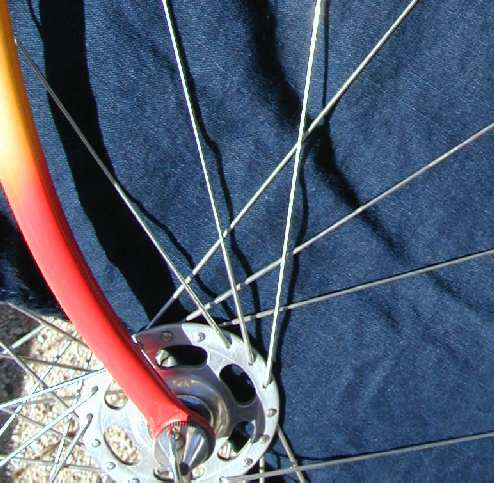a variation on 3-cross lacing for 36-spoke wheels

The photo above shows a variation on 3-cross lacing.
The only reason to use it is for its unusual appearance--the only
other advantage it offers is ease of getting your hand between
the spokes for cleaning the hub.
Compared to some other exotic spoke patterns, this one is fairly
practical. It's easy to lace, it doesn't call for mixed spoke lengths,
and (from my experience) it holds up well.
For a tutorial on general wheelbuilding technique, see Jobst Brandt's book
The Bicycle Wheel
or Sheldon Brown's
wheelbuilding instructions
web page.
To build with this pattern, use the same length spokes that you'd use
for a conventional 3-cross wheel. (Damon Rinard's
spoke length calculator
web page lists several resources for determining proper spoke length.)
The patterns on the two sides of the wheel can be offset from one another
in several different ways; in my experience, certain variations didn't
stay true as well. The pattern I've had the best results with can be
seen in the PDF file available below.
Interlacing puts more bends in the spokes than in a conventional
spoking pattern. I didn't interlace the spokes, but some people
have reported good results with interlaced spokes in this pattern.
The only advantage I know of for
interlaced spokes is the one described by Jobst Brandt in his book:
"Interlaced spokes take up each other's slack during severe radial
loading and reduce the chance of spokes becoming loose." How important
that is depends on spoke count, dish, your weight and riding habits,
and so on. I weigh about 82 kg and haven't had a problem with spokes
loosening in a 36-spoke non-interlaced front wheel.
A conventional 36-spoke wheel has 9 good choices of where to put the
valve; this pattern has only 3. But that's okay, you only need one.
This pattern looks best (to my eye) with a large-flange hub. If you start
with a used aluminum alloy hub that had been laced conventionally, some
spokes will not sit in the indentations left in the flange by the old
spokes. This is bad practice, as it can lead to hub failure.
For a detailed view of the spoke positions in the full wheel, click
here
to download a diagram in PDF (10369 bytes, viewable with the free
Adobe® Acrobat® reader
). A view of the spokes on one side of the wheel appears below.
Several people have independently devised this pattern.
It's called "3 Leading 3 Trailing" on Rowland Cook's
wheelbuilding page
.
I've only used this pattern on a front wheel. Although it's held up well,
I've stuck with conventional patterns in rear wheels for best durability.
Also, the pattern is more prominent on a
front wheel where it's not obscured by drivetrain components.
This pattern stresses a hub flange more than a conventional 3x pattern
does. See John
Allen's page about the potential hazard of exceeding the tension
that a hub flange can bear.
Tom Ace
return to Tom's home page
